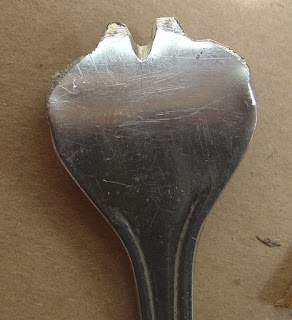Rivet setters are pieces of round bar, cylindrical steel, about 3/8 or
1/2 " in diameter, and about five inches long. Sometimes one end is
slightly concave, or spread, but many of use them flat. Remember that
whatever the shape of the end of your rivet looks like will be
reproduced on the top of the rivet itself during setting. Thats why
some are concave, to preserve the dome shape of the rivet top, and manyt
of us polish the end too so that the dome comes out nice and shiny
too. The difference between rivet setters and snap setters is that snap
setters require two different types of tools for each half of the snap,
and each has a burr or a hole in it to accomodate a recess in the snap
itself. As well, the snaps require a special plate with holes in it,
and different snaps take different sets. Your best bet is to obtain a
commercial set if you are setting snaps, or study the commercial sets to
see what you need to make.
There is a special setter for copper rivets but an old defunct hole punch can be used to slide over the post and tighten the second washer before clipping. This is what I use and the hole punch should be larger in diameter than the post of the copper rivets, but not too wode so that it falls over the edge of the washer.
When setting your regular two piece rivets, which are usually brass (The good ones) or brass plated steel (Not as good but a lot cheaper....these rust) a simple hammer strike works fine, and the flat look is desirtable to some of us. Make sure any hammer you strike with has a polished surface, ort set the rivet by hitting the bottom and driving it into thge cap which should rest on a very smooth metal or stone surface. Metal ius better.
It is not hard to polish metal surfaces with sandpaper or silicon carbide cloth.
There is a special setter for copper rivets but an old defunct hole punch can be used to slide over the post and tighten the second washer before clipping. This is what I use and the hole punch should be larger in diameter than the post of the copper rivets, but not too wode so that it falls over the edge of the washer.
When setting your regular two piece rivets, which are usually brass (The good ones) or brass plated steel (Not as good but a lot cheaper....these rust) a simple hammer strike works fine, and the flat look is desirtable to some of us. Make sure any hammer you strike with has a polished surface, ort set the rivet by hitting the bottom and driving it into thge cap which should rest on a very smooth metal or stone surface. Metal ius better.
It is not hard to polish metal surfaces with sandpaper or silicon carbide cloth.










































